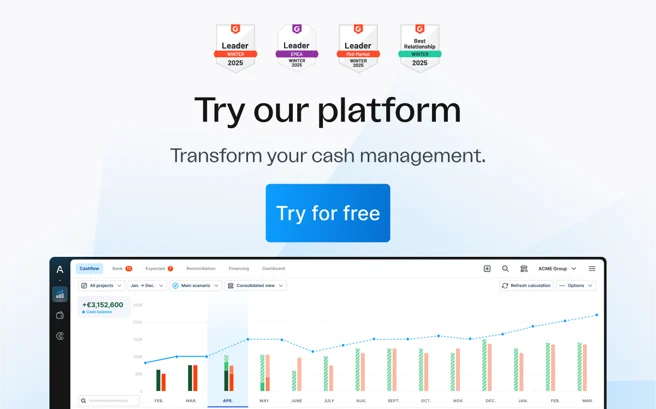Cash flow statement: Everything you need to know for better financial management

Managing a company's cash flow can sometimes be complicated. Late payments, outstanding supplier bills, overdue customer payments ... without appropriate cash flow management software like Agicap, it's easy to lose track of past and future cash flows. To help you see your sources of cash more clearly, there's a practical (if not essential) tool you can use - a cash flow statement.
Whether used for the short-term management of liquidity or for laying the ground to raise funds, the cash flow statement can make financial monitoring much easier. What are the advantages of using a cash flow statement when making decisions? How do you build one? How should the data and results be interpreted? Agicap provides all the answers in this article.
What is a cash flow statement, and why is it important? Definition
A cash flow statement is a crucial financial document for managing a company. It highlights the cash inflows and outflows during a specific accounting period. You can prepare a cash flow statement manually on paper, in Excel, or use specialised tools like Agicap to generate it quickly and accurately.
The statement is generally divided into three sections: operating activities, investments and financial activities. All cash flows provided or expended by each of the three activities are reconciled to determine the net increase or decrease in cash during the accounting period. By analysing the cash flow statement, managers can gain valuable insight into cash generation and expenditure, and forecast future cash flows.
What’s more, the cash flow statement demonstrates a company's ability to operate in the short and long term with adequate liquidity. For a company to be in good financial health, cash flow from operating income should be greater than net income; a positive cash flow demonstrates a company's ability to remain solvent and expand.
Thus, along with the balance sheet and income statement, the cash flow statement is one of the three most important financial statements for managing a company's accounts.
Why have a cash flow statement?
Whether you are a company director, entrepreneur or investor, being able to read and understand a cash flow statement is essential to assessing the financial health of your business. The cash flow statement allows you to make key decisions (commercial, strategic, investment, etc.) in an informed manner. It allows you to:
- •
assess the cash flows generated by the company's activities
- •
get an overview of the company's financial position
- •
analyse the company's ability to finance cash-generating investments and to bear the costs of its obligations
- •
determine the company's strategy and its impact on the future
- •
understand how the company generates cash and how it uses it.
The cash flow statement is a useful tool for regular financial monitoring for a number of reasons:
1. A good indicator of your liquidity
Thanks to the cash flow statement, you are perfectly aware of the state of your cash flow. You can therefore see what you can and cannot afford in terms of your strategic choices.
2. Changes in cash
You can quantify the increase or decrease in outflows, inflows, and actual cash availability in the company. These three categories form the accounting equation for measuring your business performance.
3. Forecasts of future cash flows
You can use cash flow statements to create cash flow projections. This can help you, for example, to draw up your future medium- and long-term business plans.
Cash flow statement components explained
As its name suggests, the cash flow statement brings together all cash flows and is used to manage a company's cash more effectively and consciously. It takes into account all the cash inflow and outflows.
What are the 3 sections of a cash flow statement?
In preparing the statement of cash flows, we present operating, investing and financing cash flows. Let's have a closer look at each of them.
Cash Flow from operating activities
Operating cash flow represents the cash flows generated from regular business activities. It includes the cash effects of various transactions and events related to a company's day-to-day operations.
In most cases, cash flow from operations comprises the bulk of your cash flow. If you run a restaurant, for example, the cash flow from operations is the result of your sales minus expenses (related to raw materials, equipment, rent, payroll, etc.).
See also: How does Cash flow from operations differ from other metrics?
Cash flow from investing activities
Cash flow from investing activities incorporates cash flows from the purchase or sale of assets (tangible property such as real estate or vehicles, and intangible assets such as patents) using available funds rather than debt.
You can use the formula below to evaluate cash flow from investing activities:
Cash Flow from Investing Activities = disposals of intangible and tangible fixed assets + disposals of entities (equity interests) - acquisitions of intangible and tangible fixed assets – acquisitions of entities (equity interests)
For very small businesses and SMEs, cash flow from investing activities generally accounts for only a small part of the business’s cash flow. Nevertheless, it is worth keeping an eye on it, as it can have an impact on your working capital.
Cash flow from financing activities
Cash flows from financing activities relate to income and expenses from borrowings and equity. In other words, it corresponds to the income generated and assets spent on financing activities. This may involve the repayment of part of a bank loan, the inclusion of a new investor in the capital, or the use of a credit line.
The calculation below gives the value of cash flow from financing activities:
Cash Flow from Financing Activities = Capital increase + Medium-and long-term borrowings – Repayment of medium- and long-term borrowings +/- variation in shareholder loans – dividends paid.
How is a cash flow statement prepared?
Building a cash flow statement is not an easy task, and certain documents and financial information are needed.
Here are the main documents you need:
- •
income statement;
- •
balance sheet and notes to accounts;
- •
statement of changes in financial position (change in working capital, financing transaction, dividend distribution; other financial statements as needed.).
Cash flow statement example format
Description | Amount (€) |
|---|---|
Cash flows from operating activities |
|
Net income | 80,250 |
Depreciation and amortization | 21,400 |
Increase in accounts receivable | (16,050) |
Increase in accounts payable | 10,700 |
Cash provided by operating activities | 96,300 |
Cash flows from investing activities |
|
Purchase of property, plant, and equipment | (53,500) |
Sale of investments | 16,050 |
Cash used in investing activities | (37,450) |
Cash flows from financing activities |
|
Issuance of bonds | 107,000 |
Repayment of bank loan | (26,750) |
Dividends paid | (21,400) |
Cash provided by financing activities | 58,850 |
Net increase in cash and cash equivalents | 117,700 |
Beginning cash and cash equivalents | 74,900 |
Ending cash and cash equivalents | 192,600 |
Sample cash flow statement: vertical analysis
Vertical analysis gives a standard cash flow statement (as above) a step further. This technique of financial analysis shows the proportion of each line item as a percentage of 'cash provided by operating activities'.
Below is the same cash flow statement shown above, with a column of vertical analysis added to the right. It gives a clear picture of what activities are making a significant impact on the company's cash flow.
Description | Amount (€) | % of Net Operating Cash Flow |
|---|---|---|
Cash flows from operating activities |
|
|
Net income | 80,250 | 83.33% |
Depreciation and amortization | 21,400 | 22.22% |
Increase in accounts receivable | (16,050) | -16.67% |
Increase in accounts payable | 10,700 | 11.11% |
Cash provided by operating activities | 96,030 | 100% |
Cash flows from investing activities |
|
|
Purchase of property, plant, and equipment | (53,500) | -55.56% |
Sale of investments | 16,050 | 16.67% |
Cash used in investing activities | (37,450) | -38.89% |
Cash flows from financing activities |
|
|
Issuance of bonds | 107,000 | 111.11% |
Repayment of bank loan | (26,750) | 27.78% |
Dividends paid | (21,400) | -22.22% |
Cash provided by financing activities | 58,850 | 61.11% |
Net increase in cash and cash equivalents | 117,700 | 122.22% |
Beginning cash and cash equivalents | 74,900 | 77.78% |
Ending cash and cash equivalents | 192,600 | 200% |
Thus, the finance team could quickly spot from the vertical analysis, for example, that cash used in investing activities comprised a debit of almost 39% of the cash provided by operating activities; whereas the issuance of bonds accounted for a credit of 111%.
5 Practical tips for building your cash flow statement
1. Update your cash flow statement regularly
The forecast section of your cash flow statement must be updated with the actual cash flows. Make sure you react to changes in cash flow by adjusting your cash flow forecasts so that your forecasts do not step out of sync with reality.
Read also: 5 Advantages of a Cash Flow Forecast for your Company
2. Adopt a cautious approach
Err on the side of caution when making your assumptions. Making rash predictions and setting unattainable sales targets can be detrimental and distort your forecasts, which are unlikely to reflect the reality.
3. Be thorough
Filling in your cash flow statement demands discipline and patience in order to have the information you need to manage your business. So, set some time aside to do this and enter all your company’s cash movements in the statement.
4. Take seasonality into account
A company whose volume of business varies with the time of year (high and low seasons) does not have consistent cash flows all year round: a significant drop in cash payments from sales over a given period does not necessarily mean that your expenses are any lower.
5. Think about payment terms
Granting your customers payment facilities can be an excellent way to build trust and reward their loyalty; but, be careful not to overlook the impact on your cash flow! For example, if your sales volume is high in June but you only receive payments 45 days later, you cannot count on those inflows to pay your expenses for June.
Cash flow statement : Direct and indirect methods
There are two methods for drawing up a company's cash flow statement: the direct method and the indirect method.
- •
Both methods are accepted by the IFRS (International Financial Reporting Standards) and GAAP (Generally Accepted Accounting Principles)
- •
The cash flow statements shown above are compiled using the more common indirect method.
Direct method
The direct method is based on transactional information that had an impact on cash flow during the period analysed. The direct method consists in showing the inflows and outgoing cash flows in aggregated fashion, drilling down to details like cash paid for taxes, salaries, suppliers and cash sums received by customers.
The disadvantages of the direct method are that it doesn't give a big picture overview and involves a lot of work. The advantage is that, if a finance team is looking for details, this is the format that works.
Indirect method
The second method, commonly known as the indirect method, is based on accrual accounting. Basically, a company's accountant records income and expenses with a time lag in relation to cash transfers. This means that these accrual entries and adjustments (i.e. cash flows from operating activities) differ from net income.
Using the indirect method, the accountant starts with the amount of net income obtained from the income statement and makes adjustments to cancel out the impact of accruals and deferrals made during the period. Then the net income is converted into a real cash flow by identifying all the non-cash expenses of the period analysed (such as depreciation, the reduction in the value of an asset, amortisation or the spreading of payments over several accounting periods).
The advantage of the indirect method is that, because it uses information available from the income statement and balance sheet, it is faster to compile than the direct method. The disadvantage is that it does not show specific cash inflows and outflows.
Analysing the company's cash flows
Performing a regular cash flow audit is a great way to assess a company's financial health by monitoring changes in cash flow, and therefore be well-placed to make informed decisions. Further, if a company wants to explore acquiring investment via cash flow financing, a cash flow audit is imperative to establish net cash flow now and in the future.
Net cash flow is generally referred to as either positive (the company receives more cash than it spends) or negative (the company spends more than it receives).
Positive cash flow
A positive cash flow means that a company has more money coming in than going out over a given period. In theory, this is an ideal situation. Thanks to the surplus cash it generates, the company can reinvest this excess cash to expand, decide to reward its shareholders or pay off its debts. But bear in mind that a positive cash flow does not necessarily lead to profits. Your business can be profitable without having a positive cash flow, and you can have a positive cash flow without making a profit.
Negative cash flow
Are your cash outflows greater than your cash inflows during a specific period? This means your cash flow is negative. Don't panic: negative cash flow doesn't necessarily mean you're making a loss in the medium or long term. On the contrary, it may be caused by important decisions taken some time ago to expand your business or invest in your growth. However, if you observe a mismatch between your expenses and revenues for several accounting periods in a row, you need to take action to reverse the trend as soon as possible.
Based on this information, an investor may decide, for example, that a company with irregular cash flows is too risky to invest in, or that a company with positive cash flows is ready for expansion. Further, managers outside the finance department can examine a cash flow statement to understand the impact of their departments on the company's finances. They will then be able to make adjustments and adapt the operations of the department (budget, hiring, lay-off, etc.).
Change in WC
The surplus of assets over liabilities is called the company’s working capital (WC). The change in working capital is therefore the difference between the working capital of two separate accounting periods (year, quarter or month). To calculate the WC, current liabilities are simply subtracted from current assets.
Change in working capital is included in cash flow from operating activities, since a company generally increases or reduces its current assets and liabilities to finance its ongoing operations. There are two possible scenarios:
- Increase in current assets: this is an outflow of funds. The company has to pay out money to buy extra assets.
- Increase in current liabilities: this is an inflow of funds. Extra debts, such as short-term debts, provide the company with cash.
Interpreting changes in working capital for a company
Depending on the company's history and strategy, it is generally possible to explain these variations as follows:
- •
when the change in working capital is negative, it may mean that the company is investing heavily in its current assets or significantly reducing its current liabilities;
- •
conversely, if the change in working capital is positive, the company is selling current assets or increasing its current liabilities.
For many businesses in the growth phase, changes in working capital mainly correspond to capital expenditures: this is the cash that the business decides to invest in order to develop. A company must therefore calculate this change to be sure that its WC is sufficient, and it will not end up short of funds.
Cash flow statement vs. cash flow projection: Simplify your financial management with Agicap
- •
Past cash flow statement: A detailed and accurate cash flow statement is essential for analyzing all financial flows over a specific period. However, manually creating this statement can be time-consuming and prone to errors. Why not let Agicap handle it for you with precision and ease?
- •
Cash flow projection: Planning ahead is key to business success. Whether you're redefining your strategy or updating your business plan, a cash flow forecast is indispensable. Typically prepared annually, it aligns with your development plan and investment returns. With Agicap, you can create and adjust your cash flow projections effortlessly, ensuring your business stays on track.
Take control of your cash flow management today. Build, update, and optimise your financial statements with Agicap—quickly and accurately.
Test Agicap for free and experience the difference!






